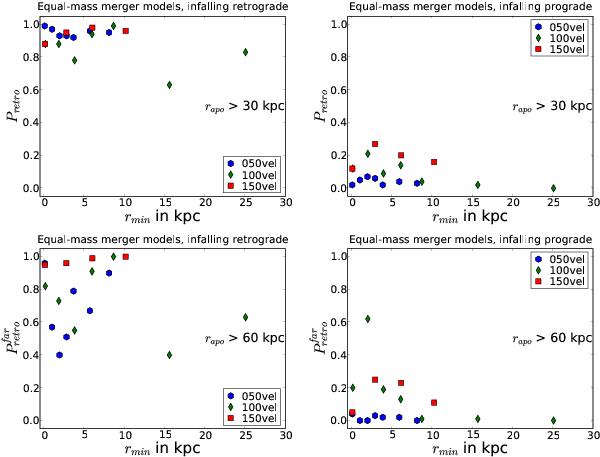Fig. 11

Equal-mass-mergers: the fraction of particles on retrograde orbits with apocentres above 30 kpc (Pretro, upper panels), and above 60 kpc ( , lower panels) after the merger. The panels on the left show models with retrograde, those on the right prograde spin orientation of the infalling galaxy. See Tables B.3 to B.6 for the values. The symbols reflect the initial velocities, with “050vel” standing for 0.5, “100vel” for 1.0 and “150vel” for 1.5 times the parabolic velocity, calculated assuming the initial galaxies are point masses. Mergers where the infalling disc has a retrograde angular momentum (left panels) lead to the highest fractions of retrograde material in the models computed. There is no simple dependence on the initial relative velocity of the galaxies, but for the subset of far particles, faster interactions tend to lead to higher values in Pretro. Mergers where the infalling disc has a prograde spin angular momentum (right panels) lead to low fractions of retrograde material. Similar to the fly-by interactions, faster initial velocities lead to higher fractions of retrograde material. But in contrast to the fly-by cases, Pretro does not drop when considering only the subset of far particles, because of the more similar radial distribution of particles on pro- and retrograde orbits. See the on-line edition of the article for a colour version of this figure.
, lower panels) after the merger. The panels on the left show models with retrograde, those on the right prograde spin orientation of the infalling galaxy. See Tables B.3 to B.6 for the values. The symbols reflect the initial velocities, with “050vel” standing for 0.5, “100vel” for 1.0 and “150vel” for 1.5 times the parabolic velocity, calculated assuming the initial galaxies are point masses. Mergers where the infalling disc has a retrograde angular momentum (left panels) lead to the highest fractions of retrograde material in the models computed. There is no simple dependence on the initial relative velocity of the galaxies, but for the subset of far particles, faster interactions tend to lead to higher values in Pretro. Mergers where the infalling disc has a prograde spin angular momentum (right panels) lead to low fractions of retrograde material. Similar to the fly-by interactions, faster initial velocities lead to higher fractions of retrograde material. But in contrast to the fly-by cases, Pretro does not drop when considering only the subset of far particles, because of the more similar radial distribution of particles on pro- and retrograde orbits. See the on-line edition of the article for a colour version of this figure.
Current usage metrics show cumulative count of Article Views (full-text article views including HTML views, PDF and ePub downloads, according to the available data) and Abstracts Views on Vision4Press platform.
Data correspond to usage on the plateform after 2015. The current usage metrics is available 48-96 hours after online publication and is updated daily on week days.
Initial download of the metrics may take a while.






